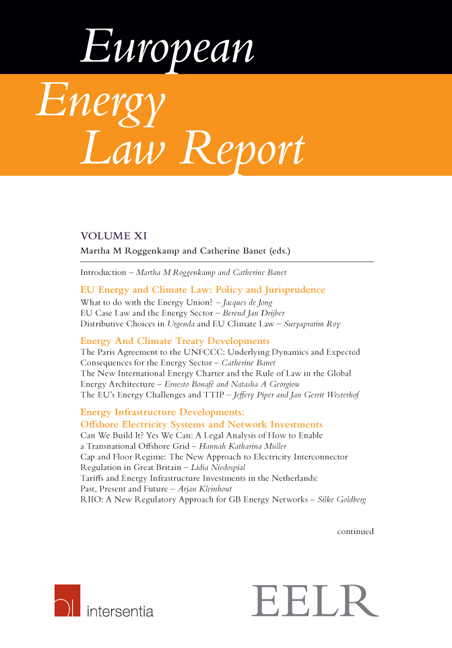Book contents
- Frontmatter
- Editorial
- Contents
- List of Abbreviations
- List of Contributors
- Introduction
- Part I EU Energy and Climate Law: Policy and Jurisprudence
- Chapter I What to do with the Energy Union?
- Chapter II EU Case Law and the Energy Sector
- Chapter III Distributive Choices in Urgenda and EU Climate Law
- Part II Energy and Climate Treaty Developments
- Part III Energy Infrastructure Developments: Offshore Electricity Systems and Network Investments
- Part IV Heat Supply Legislation in the Eu
- Part V Security of Energy Supply and Safety
Chapter I - What to do with the Energy Union?
from Part I - EU Energy and Climate Law: Policy and Jurisprudence
Published online by Cambridge University Press: 29 September 2018
- Frontmatter
- Editorial
- Contents
- List of Abbreviations
- List of Contributors
- Introduction
- Part I EU Energy and Climate Law: Policy and Jurisprudence
- Chapter I What to do with the Energy Union?
- Chapter II EU Case Law and the Energy Sector
- Chapter III Distributive Choices in Urgenda and EU Climate Law
- Part II Energy and Climate Treaty Developments
- Part III Energy Infrastructure Developments: Offshore Electricity Systems and Network Investments
- Part IV Heat Supply Legislation in the Eu
- Part V Security of Energy Supply and Safety
Summary
INTRODUCTION
Seen from the European point of view, energy should have always been a catalyst for common actions by the Member States. The 1951 Coal and Steel Treaty and the 1957 Euratom Treaty are there to show that if there was something to govern together, it was energy. Many arguments have been exchanged about this mantra since the late 1950s, when the idea to create ‘une politique de l' énergie communautaire’ was first suggested and the three executive bodies of the three Treaties were asked to come forward with an outline. This failed however due to significant differences of opinions and interests between the (then) six Member States. It took about 50 years before the European Union (EU) finally agreed in March 2007 on an ‘Energy Policy for Europe ’, covering the three basic objectives for energy policy, ie supply security, sustainability and competitiveness. This decision was taken at the highest political level and could be considered a turning point.
Shortly after that, Member States recognized the energy domain as part of the new EU Treaties, confirming however that energy is a shared competence to be exerted at EU and national levels with subsidiarity as a general principle. The combination of the two levels is a very complicated one, even more so as several Member States and their (often state-owned) energy companies are still denying the European dimension, making their national energy markets immune from ‘foreign’ intervention. Therefore, energy remains a very politically charged sector, where the principles of free movement of goods and services that are at the roots of the common internal market, are still challenged in potential supply shortfalls. Governance thus has a clear role in the field of energy and needs to be clearly defined for the effective management of the energy policy objectives at the European, regional, national and local levels so that the energy needs of consumers met, at an affordable price and with a clear willingness to reduce the environmental and climate impacts of energy consumption.
In EU energy policy-making, the year 2015 has become the year of the Energy Union. Is this simply a new concept, a new name, a new tag for the existing set of EU energy policy initiatives?
- Type
- Chapter
- Information
- European Energy Law Report XI , pp. 11 - 28Publisher: IntersentiaPrint publication year: 2017



